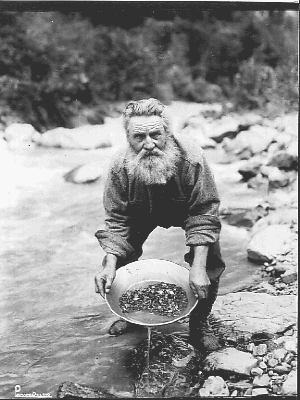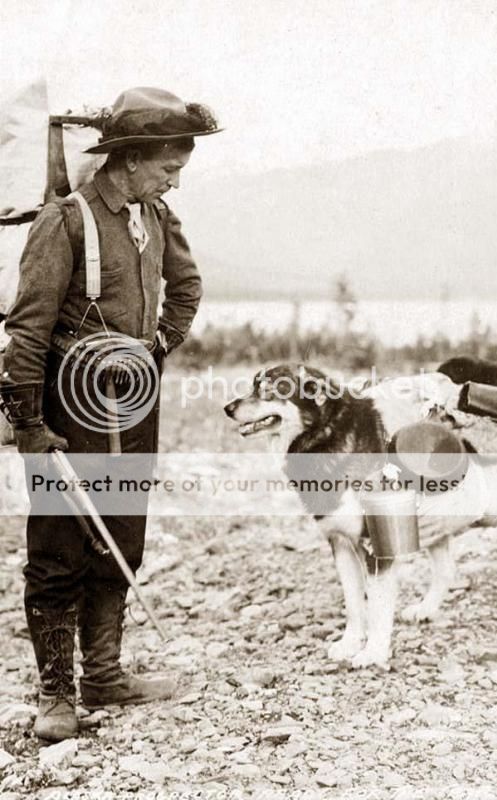ShopDreamUp AI ArtDreamUp
Deviation Actions

The origin of the city's name "Nome" is still under debate. The name may have been given by Nome's founder, Jafet Lindeberg: within trekking distance of his childhood home in Kvænangen, Norway, there is a Nome valley (Norwegian: Nomedalen).
An alternate theory is that Nome received its name through an error: allegedly when a British cartographer copied an ambiguous annotation made by a British officer on a nautical chart, while on a voyage up the Bering Strait. The officer had written "? Name" next to the unnamed cape. The mapmaker misread the annotation as "C. Nome", or Cape Nome, and used that name on his own chart; the city in turn took its name from the cape. The name may also be a misunderstanding of the local Inupiaq word for "Where at?", Naami as it shares an identical pronunciation.
In February 1899, some local miners and merchants voted to change the name from Nome to Anvil City, because of the confusion with Cape Nome, 12 miles south, and the Nome River, the mouth of which is 4 mi south of Nome. The United States Post Office in Nome refused to accept the change. Fearing a move of the post office to Nome City, a mining camp on the Nome River, the merchants unhappily agreed to change the name of Anvil City back to Nome.
By 1905 Nome had schools, churches, newspapers, a hospital, saloons, stores, and a post office, an electric light plant and other businesses. A hothouse on the sand-spit across the Snake River provided fresh vegetables. Some of the first automobiles in Alaska ran on the planks of Front Street. Travelers going to the mines at Council City rode in heated stages. In 1904 the first wireless telegraph in the United States to transmit over a distance of more than 100 miles began operating in Nome. Messages could be sent from Nome to St. Michael and from there by cable to Seattle.
Nome had no harbor for ships during the rush, only one for local boats. Ships anchored offshore and people were shuttled ashore in boats. In early summer the coast could still be covered with ice. In that case passengers would be put off on the ice and brought ashore by dog sledges. In 1901 a loading crane was built and in 1905 a wharf. This was by 1907 replaced by or combined with a tramway. Together with the tramway, which was 1,400 feet long, people and freight were brought ashore by wire-pulled lighters.
The biggest losers were probably the natives. Mining claims could only be staked lawfully by citizens. Since natives were considered to be uncivilized, they could not get citizenship. For them, the gold rush meant a drastic reduction in moose, caribou, and small game as prospectors hunted these for food. In many areas, gold mining resulted in destruction of salmon streams. Contact with white men also had consequences like drinking and disease.
Nome has a subarctic climate, with long, very cold winters, and short, cool summers. However, conditions in both winter and summer are moderated by the city's coastal location: winters are less severe that in the Interior, and conversely, summers are lukewarm. The coldest month is January, averaging 5.2 °F, although highs may breach the freezing point on 2–4 days per month from December to March and there are 74–75 days annually of 0 °F or lower temperatures, mostly from November to April. Average highs stay below freezing from late October until late April, and the average first and last dates of freezing lows are August 30 and June 9, respectively, a freeze-free period of 81 days. The warmest month is July, with an average of 52.2 °F; temperatures rarely reach 80 °F or remain above 60 °F the whole night. Snow averages 76 inches per season, with the average first and last dates of measurable snowfall being October 4 and May 16; accumulating snow has not been officially observed in July or August. Precipitation is greatest in the summer months, and averages 16.8 inches per year.
Inupiat hunted for game on the west coast of Alaska from prehistoric times and there is recent archaeological evidence to suggest that there was an Inupiat settlement at Nome, known in Inupiat as Sitnasuak, before the discovery of gold.
In the summer of 1898, the "Three Lucky Swedes": Norwegian-American Jafet Lindeberg, and two naturalized American citizens of Swedish birth, Erik Lindblom and John Brynteson, discovered gold on Anvil Creek. News of the discovery reached the outside world that winter. By 1899, Nome had a population of 10,000 and the area was organized as the Nome mining district. In that year, gold was found in the beach sands for dozens of miles along the coast at Nome, which spurred the stampede to new heights. Thousands more people poured into Nome during the spring of 1900 aboard steamships from the ports of Seattle and San Francisco. By 1900, a tent city on the beaches and on the treeless coast reached 30 mi, from Cape Rodney to Cape Nome.
Many late-comers were jealous of the original discoverers, and tried to "jump" the original claims by filing mining claims covering the same ground. The federal judge for the area ruled the original claims valid, but some of the claim jumpers agreed to share their invalid claims with influential Washington politicians. Alexander McKenzie,took an interest in the gold rush and secured the appointment of Arthur Noyes as the federal district judge for the Nome region for the purpose of taking control of gold placer mines in Nome. McKenzie seized mining claims with an unlawfully-procured receivership granted by Judge Noyes. Mckenzie's claim-jumping scheme was eventually stopped by the federal Ninth Circuit Court of Appeals. However, the episode provided the plot for Rex Beach's best-selling novel The Spoilers (1906). Wyatt Earp, of Tombstone, Arizona fame, stayed in Nome for a short period, but little is known of his activities there.
During the period from 1900−1909, estimates of Nome's population reached as high as 20,000. The highest recorded population of Nome, in the 1900 United States census, was 12,488. At this time, Nome was the largest city in the Alaska Territory. Early in this period, the U.S. Army policed the area, and expelled any inhabitant each autumn who did not have shelter (or the resources to pay for shelter) for the harsh winter.
The Nome Gold Rush was a gold rush in Nome, Alaska, approximately 1899-1909. It is separated from other gold rushes by the ease of which gold could be obtained. Much of the gold was lying in the beach sand of the landing place and could be recovered without any need for a claim. During the rush Nome was a sea port without a harbor, and the biggest town in Alaska.
Together with the Klondike Gold Rush (1896–1899), Nome is the biggest gold rush associated with Alaska.
The center of the Nome Gold Rush was the town of Nome at the outlet of Snake River on the Seward Peninsula at Norton Sound of the Bering Sea. Inupiaq Eskimos had camped for centuries in the Nome area before Russians came. In the 18th century, they established the port of St. Michael, 125 miles to the southeast, for sailing on Yukon. Fur traders and whalers from many countries visited the area. A few church missions were established beginning in the 1880s. Gold was found in smaller amounts at Council 1897, the year before Nome, and subsequently other places in the area.
Claim jumping was mostly a problem before the beach gold was found, since it could not be claimed and there was plenty of it. As a matter of fact, the beach gold seems to have been more important than the claimed gold in the creeks. The mining of Nome beach is a good example of gold rushes going through phases of increasing use of machinery and capital. The very first gold on the beach was found with a pan. Later in the summer of 1899 human powered equipment like sluices and rockers were present. In 1900 small machines together with hoses and pumps were seen at the beach, and finally from around 1902 big companies took over. The season wasn't long. Due to ice, the beaches could only be worked from June to October. Local police forced people with inadequate shelter to leave for the winter.
Panning creeks for gold in Alaska is slow and cold. As in Klondike there was a layer of permafrost just below the surface. In Nome different kinds of equipment were used to thaw the ground and suck up gravel. The mining methods used were extensive meaning that the amount of soil processed was more important than the efficiency of the equipment that separated gold from sand. By hydraulic methods soil was washed off the creek banks and into sluices either by gravity or suction. Dredges and in some cases mine shafts were used. To facilitate digging the ground was softened with steam. Steam was also used for collecting dumps of gravel in the winter. The gravel was sluiced the next summer.
The legacy of the Nome gold rush is somewhat obscured by the fame of Klondike. The two gold rushes, however, should not be confused. Both Klondike and Nome are often thought of as Alaska gold rushes, even though strictly speaking only Nome was. The center of the Klondike gold rush was Dawson City in Yukon, Canada and therefore outside Alaska, but reached via Alaska. Klondike River giving name to the rush is a tributary of the Yukon River, which runs through Alaska and ends in Norton Sound opposite Nome. For that reason, Yukon River too is associated with both rushes. As mentioned earlier, there was an overlap of prospectors between Klondike and Nome and, finally, the two rushes shared some of the same routes.
Some links to pictures and some history that would be happening around the world.
commons.wikimedia.org/wiki/Cat…
americasbesthistory.com/abhtim…






Below are various occupations your character could have, but are not limited to; if you find anymore please feel free to use them and I'll post them here!
Most of these positions could also have an 'apprentice'.
Baker
Butcher
Sheriff
Deputy
Veterinarian
Doctor
Nurse
Teacher
Hunter
Fur Trapper
Post Office
Bank
Soldier
About Faction Creation
:bigthumb636612619:Creating a Faction
You there!
Are you looking to create a new faction of your own to add to our community? Perhaps you’d like to start a wolf pack, or another gang to trouble the town? Perhaps you want your character to start a special, official business, or even a rebellion group of sorts?
Here, you can find out how to start!
First thing’s first, of course— please make sure you check our Home page (under ‘Resources’) to see if the faction creation slots are open!
Every faction must have a leader of sorts. You can either have a current character lead in the birth of your group, or you can c
Poll: New Application Sheets?
Hello everybody!
As work is done to reconstruct some of the group’s journals etc., the decision had been made to try and revamp the character applications!
Here is the idea for a format:
https://sta.sh/0n351w0f5rh
There will be an actual background for each faction, of course, rather than one color. The thought that will also be put forward is to remove separate coydog, coywolf, wolfdog, and feline Applications. Instead, if you have any of these, you will put it on the Stray or the Pet application according to their status.
Now comes the question:
Being that we want to give attention the community’s thoughts as well, to make
Joining our Staff
We are currently
>OPEN<
for group staff tryouts
Would you like to join the group’s Staff team? If we’re open for new members to our Administration, we’d love to have you!
It doesn’t require much to be part of the team depending on the job you’re given! However, we put it up to you to choose the task you feel you can accomplish, and you are expected to work with this task. We understand of course if there are things irl that hold you back from full activity, but should you have a prolonged inactivity and a silence in any discussion, you will be moved to Members and set to the rules there as any Member woul
!GRP! Lucky Catch | Spanielano Gang Event
Some of the fishermen on the boats near the Spanielano’s headquarters have lost their nets, and the catch has swam to shore!
The news comes suddenly that now an entire school of fish has flooded the beach and shallows near the headquarters, and knowing that more benefit can be found in numbers, the whole gangs rallies to bring in what they can of the catch— will your dog help take in some of this good fortune to feed themselves and the gang?
Rules
•
This role play is for Spanielanos only!
•
Do not reply to somebody’s post— follow the directions below.
•
You will have a three day opportunity to ha
Featured in Groups
© 2014 - 2024 Season-Of-White
Comments0
Join the community to add your comment. Already a deviant? Log In
